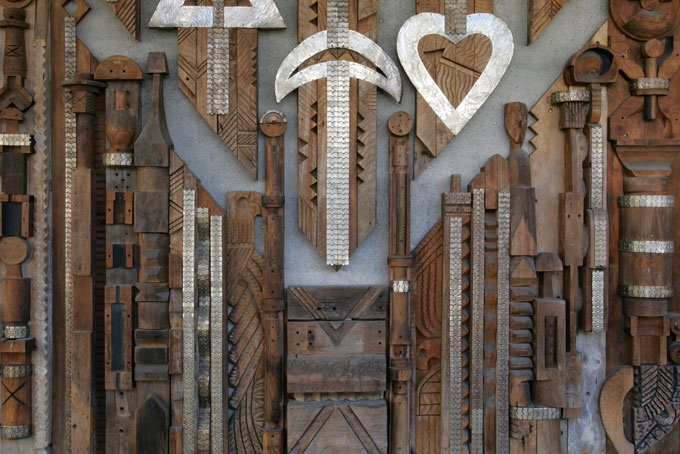
Metal and wood sculpture
Taken from ‘Aotea Centre Works of Art’, edited by Tara Werner, written by Karen Scherer and Katherine Findlay.
The massive metal and wood sculpture rising for two levels on the interior and exterior walls of Aotea – Te Pokapū | Aotea Centre is an untitled work by Paratene Matchitt.
This work is one of a group commissioned for the Aotea Centre. The piece is “divided” by a balcony running around Level 5 of the Aotea Centre, with the top part viewable from afar as well as close up, and the bottom section viewable from Level 3 of the Centre. Partly obscured from view and partly not, it is a bold piece of work that Matchitt believes will be viewed in different ways by different people.
A massive metal and wood sculpture, although untitled, could be summed up by the Maori word manaaki which means hospitality. Matchitt's interpretation of the work is that the powerful pieces of timber at the bottom of the mural represent the people of today, while the stainless steel forms at the top are their ancestors, both Māori and Pākeha.
The large central diamond shape symbolises hospitality. It links the past and present and contains the hearts, moons, stars and crosses which have become Matchitt's signature.
Paratene Matchitt:
The idea of hospitality came very early. The whole building needs to be hospitable to the people who are coming into it, and my mural supports that idea. It is also meant to scramble people's minds about all that sort of thing.
Matchitt also sees the sculpture as representing the development of Aotearoa New Zealand. He has included historical references such as the early planting of kumara, as well as both individual and collective stories about particular ancestors.
All the timbers are from Aotearoa, and some have been used in previous constructions. The metal strips came from a scrap metal dealer and include a conveyor belt from an old tannery in Hastings. The combination of these quite different materials in one work show that the two cultures are indeed compatible. Matchitt worked mostly with power chisels, industrial sanders and a chainsaw. The result is a robust and gutsy relief which will have the finishing touches put on it by Tawhiri Matea – God of the Elements.
Artist: Paratene Matchitt
Date of work: 1990
Medium: Metal and wood
